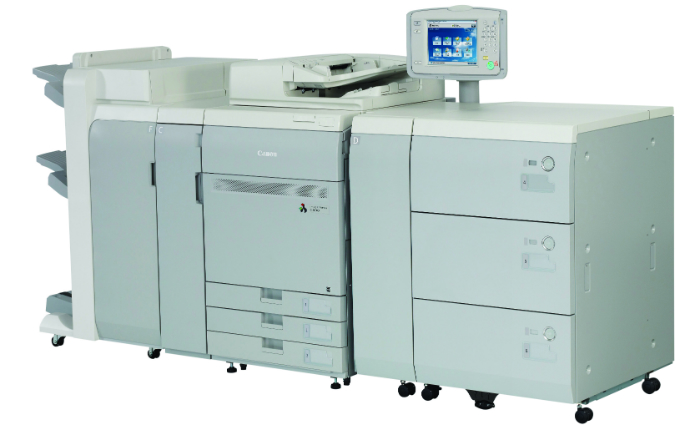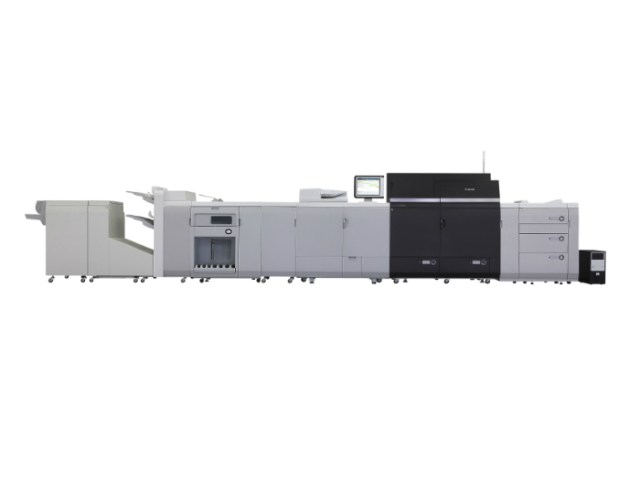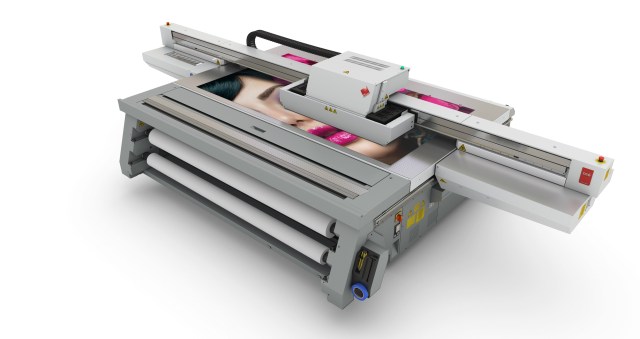
Light production is one of the most hotly-contested digital printer sectors, although it is one Canon has been under-represented in. While it has had a light production machine, the imageRunner Advance C9280 Pro, there was a large jump from that machine to its top-end colour production presses, the imagePress C7011 series.
While the iR9280 Pro sat well in the high-end office it was not so suited to CRD, inplant and print-for-pay or franchise markets. To fill the gap, Canon has launched the imagePress C800 series, a range of three colour printers with a throughput of 60, 70 or 80 A4ppm. The target monthly print volume is 40,000 to 70,000 A4 pages.
It can be forgotten in this era of multiple colour digital print vendors that Canon was a pioneer in this field, before even Indigo and Xeikon with its CLC range. From that heritage, Canon has poured resources into its R&D and created the new C800 range, which it believes will give printers the reliable quality workhorse they crave.
At the heart of the C800 is a new imaging unit. Like other Canon, and many rival machines, it uses Vertical Cavity Surface Emitting Laser (VCSEL) lasers, a 32 multi-beam system to be precise. That results in 2400dpi resolution at 8-bits per pixel, which delivers flexibility in the screening and image geometry. The upshot of that is accurate image placement to compensate for distortions caused by paper skew and shrinkage. This bolsters the beefed up four-stage mechanical registration system.
Combined, they deliver greatly improved front-to-back of the sheet registration, down to less than 1mm.
Image quality is said to be much better. A new CV (which stands for Colour Vivid) toner produces brighter, punchier colours than previous Canon products.
Jeremy Plint, Canon assistant general manager for marketing, says, “It is based on customer feedback. Canon has always strived for realistic, accurate colour output, which has sometimes been criticised for lacking brightness. The new toner is a good balance. It keeps the accuracy but with a more vivid and luscious image.”
The toner particles are also smaller and have a lower melting temperature, which helps lower power consumption.
Features that address the needs of the print-for-pay market include full engine speed on paper up to 220gsm, with stepped slowdown as materials get heavier. On the 80ppm version for stocks of 221gsm to 256gsm it slows to 60ppm, and from 257gsm up to the maximum rated weight of 300gsm handles 40ppm.
Another key feature for the print-for-pay market is its brisk speed on larger sheets. Canon argues that unlike rivals, which slow down dramatically if you want to print SRA3 or SRA3+ sheets the C800 maintains a respective parity with A4. SRA3 sheets on the C800 are, with the same weight paper, 40, 30 and 20ppm. Even in SRA3 it maintains an impressive, if slightly arbitrary, 40, 29, 20 sheets per minute respectively.
“That is important as almost everyone in light production wants SRA3 sheets,” says Plint.
An interesting niche addition is a long sheet and banner mode, which supports paper up to 30” (762 mm) long. Applications include landscape A4 photobooks, book dust jackets and throw-outs and 6pp products.
“Long sheets seem to be one of those features that figure heavily in demos but are not used too much,” says Plint.
“But they do fit a niche for some specialist applications that can command a better price.”
Feeding options include a multiple drawer feeder able to hold a total of 6000 sheets or the Pod, that can hold up to 3500 sheets.
On the output side for near line and offline finishing there is a high-capacity stacker in addition to a number of online finishing options.
The one most likely to appeal to the print for pay market is the Pro finisher, which is an option on the two faster (70 and 80ppm) machines. It features a folding unit, a saddle finisher and two trimmers, one for the fore edge trim and then a two-knife configuration for the head and tail. That means it is possible to produce full-bleed stitched products up to 100pp inline.
Canon’s new product manager, cut sheet production industry veteran Henryk Kraszewski, says “We think print-for-pay, print rooms, franchises and agencies producing pitch books will love this inline finisher,” he says.
New to a Canon light production machine on the C800 are more operator replaceable components, which contribute to more uptime, and so potentially a faster ROI.
“What matters to printers is how many sheets per hour or jobs per shift they can get out the door, so there are a lot of little things we have done to help improve that.”
A raft of enhancements to the on-board calibration tools also means that quality should be more consistent. Automatic and Reciprocal Color Density Adjustment Technology (Arcdat) adjusts the toner gradation and density.
It is a real-time calibration technology, which works by checking colour patches on the surface of the ITB belt. While Arcdat has been employed by Canon before, what is new on the imagePress C800 is that it uses five patches for each of the four toners rather than the single patch per colour previously used, which ensures more accuracy throughout the tonal range.
Kraszewski says, “The previous version was great for ensuring the solids remained in specification, with Arcdat we extend that to the halftones, which helps ensure consistency on the run.”
The process is carried out automatically, measuring the patches on the intermediate transfer belt, with a full scan every 82 pages.
Measuring from the belt in the background means no paper is used or production time lost, so users do not have to compromise and will not forego calibration for a bit more production.
Auto Correct Color Tone (ACCT) is another new calibration technology, which goes beyond the previous Auto Gradation Adjustment (AGA) technology. While AGA linearises the tone reproduction of individual CMYK channels, ACCT covers multi-dimension mixed colours, that is a mix of two or more channels, which is a first in a Canon light-production device.
ACCT relies on a series of test prints that are measured using the built-in scanner and compared to a reference file created during installation, enabling the machine to be returned to the same state as when it was commissioned. It is like fingerprinting a litho press. Canon sees users carrying out the process every few days or every week depending on how colour critical their requirements are.
Canon’s earlier light production machines struggled with textured papers. By borrowing the elastic intermediate transfer belt from the bigger imagePress the C800 can now handle heavily textured papers, recycled papers and envelopes. Together these changes open up a wider range of applications.
Another benefit of the enhanced imaging and fusing systems is the toner now better matches the gloss of the underlying paper.
There is a wide range of front-end options for the C800. Canon’s own Prismasync is one option. New EFI Fiery-based systems, the G100 and the F200, will be the first commercial incarnations of EFI’s latest Fiery FS 150 Pro DFE, which promises speeds up to 55 per cent faster than rival rips.
The EFI Fiery will be available in both standalone and embedded versions, with the standalone expected to be the rip of choice for print-for-pay and larger inplants. A Creo rip is also an option, which Canon says is important for the Australian market as there are many Creo users out there.
The new imagePress C800 series is a well-configured printer with a range of features that should send it straight onto the shortlist of every printer looking for a light production colour printer.
THE ALTERNATIVES
FUJI XEROX C75/J75
Also has the two-knife and fore edge trim options to produce full bleed booklets.
Both Xerox machines offer 75ppm throughput, the heavier-duty J75 can maintain that speed regardless of stock, while the C75 slows down to 51ppm for coated and heavyweight papers.
Speed: 75 A4ppm
Paper weight: 64gsm to 300gsm
Contact: 1300 258 192 www.fujixerox.com.au
KONICA MINOLTA BIZHUB PRO/PRESS C1060/1070
Launched at virtually the same time as the C800, this five machine range is available in 60 and 71ppm versions. They have a 1200 x 1200dpi image resolution, which the company says is actually 3,600dpi, thanks to the 8-bit multi-gradation Sead IV processor, and this in conjunction with the new Simitri HD++ toner is what delivers the quality.
Speed: 61, 71 A4ppm
Paper weight: 62gsm to 300gsm
Contact: 1800 789 389 www.konicaminolta.com.au
RICOH C751 PRO
Ricoh claims higher resolution at 1200 x 4800dpi thanks to a 40-beam VCSEL laser. Monthly print volume of 180,000 A4 pages. The light production machine is also marketed by Lanier, and famously by Heidelberg.
Speed: 75 A4ppm
Paper weight: 52gsm to 300gsm
Contact: 1800 181 002 www.ricoh.com.au
Comment below to have your say on this story.
If you have a news story or tip-off, get in touch at editorial@sprinter.com.au.
Sign up to the Sprinter newsletter


